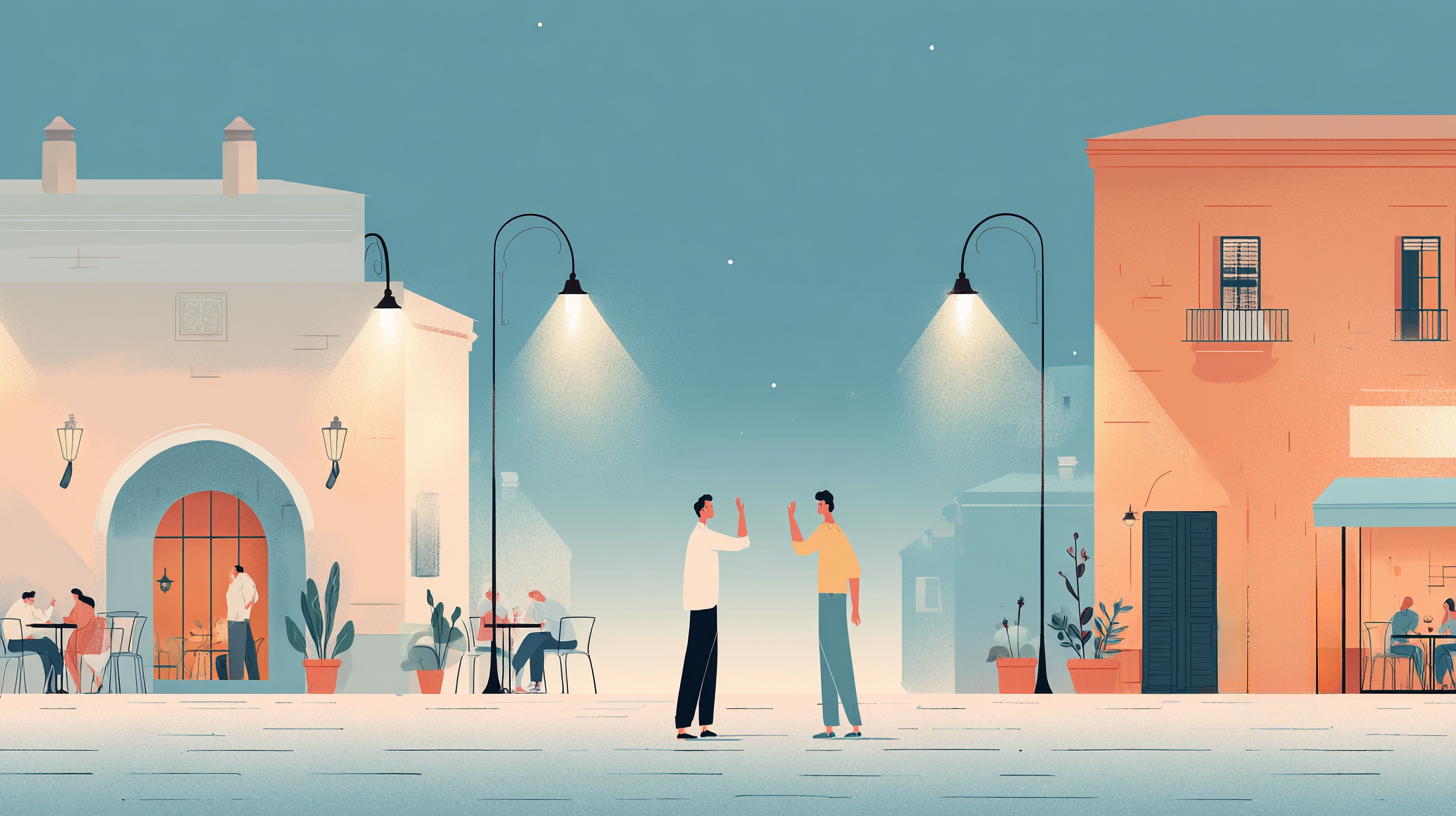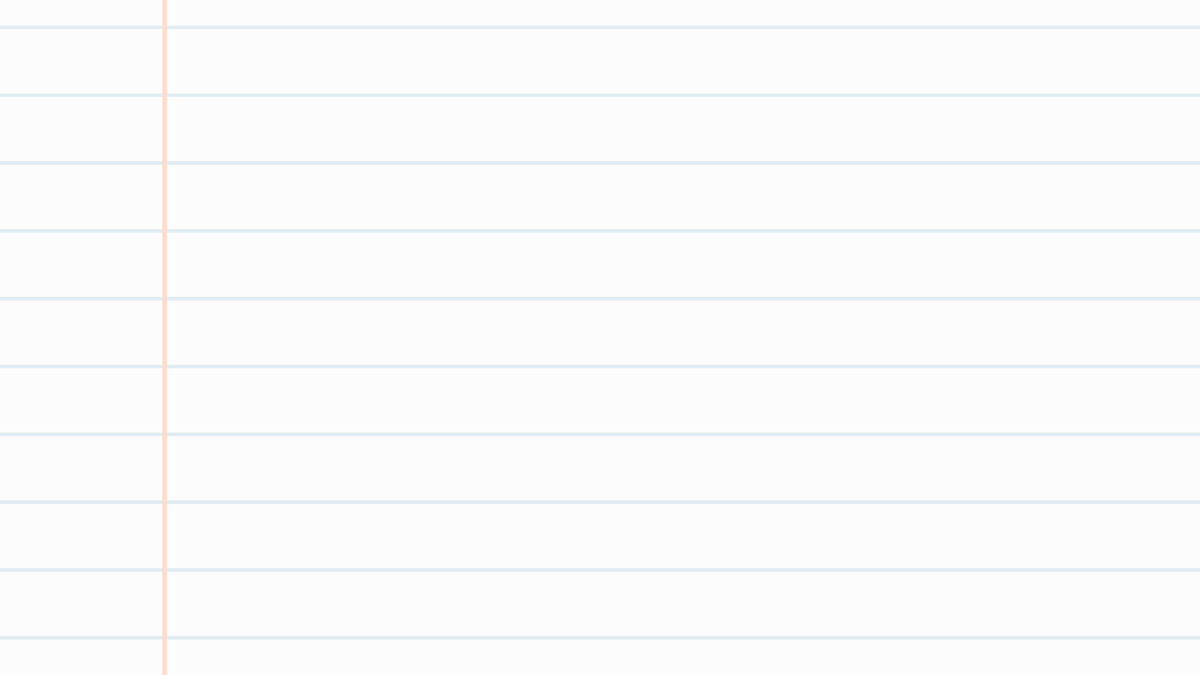Intro.
In Italy, greetings are much more than simple social conventions: they are authentic expressions of human warmth, respect, and cultural belonging. Whether it's a casual encounter at a café, a business meeting, or a warm embrace between longtime friends, Italian greetings reflect the richness of human relationships and the importance of courtesy in daily life.
Italians have developed a complex and nuanced system of greetings that vary according to the time of day, degree of familiarity, age of the people involved, and social context. From the most formal yet energetic morning "buongiorno" to the warm "ciao" between friends, each greeting carries a precise message.
Before diving into the vocabulary of Italian greetings, let's take a moment to observe some interesting linguistic aspects. Many greetings in Italian, in fact, arise from the combination of the adjective "buono" (good) and a noun: this is the case with formulas like "buona giornata" and "buona serata," where the adjective regularly agrees in gender and number with the noun. In other cases, the adjective and noun have formed a single word: buongiorno (from "buon" + "giorno"), buonasera (from "buona" + "sera") and buonanotte (from "buona" + "notte"). These combinations, now crystallized, are perceived by speakers as autonomous lexical units. Alongside the combined forms, there are also the separate variants (buon giorno, buona notte), especially in written greetings. Between the two, today the combined form is preferred, which should always be used when the terms have substantive value: "Il buongiorno si vede dal mattino" (You can tell a good day from the morning); "Gli ho augurato la buonanotte" (I wished him good night).
Another small grammatical reflection: have you noticed that many farewell formulas are introduced by the preposition "a"? These are expressions like "A presto" (See you soon), "A dopo" (See you later), "A più tardi" (Until later). The preposition "a" introduces a temporal reference that refers to a subsequent meeting. Sometimes the simple preposition "a" becomes an articulated preposition, and then we have formulas like "Alla prossima!" (Until next time!).
You'll have already noticed that greetings are experienced as true communication bridges: they create immediate connections and establish the tone of every interaction.
This complete guide will help you master the art of Italian greetings, from the most common expressions to the most specific ones.
Are you ready? Get ready to say "Ciao" to the world of Italian greetings!

Essential Italian Greetings for Daily Conversation
Greetings form the backbone of Italian social communication. The list we propose includes the first greetings that every Italian student learns and those they will use most frequently in daily communication. From morning to evening, these greetings accompany the moments of the Italian day.
1. Ciao - The Universal Italian Greeting
Perhaps the most well-known Italian word in the world, "ciao" has become the very symbol of Italian spontaneity. It's a short and musical greeting that works both when arriving and when saying goodbye. It's a word used millions of times a day, among friends, family members, and colleagues in informal contexts.
In English, it can correspond to "Hi," "Hello," or "Bye," depending on the context. "Ciao" is answered simply with "ciao." Alternatively, and more informally and familiarly, you can respond with "ehi" or "ehilà".
Tone: friendly, neutral, spontaneous.
Example:
A: Ciao, Marina!
B: Ciao, Paolo!
A: Hi, Marina!
B: Hi, Paolo!
A: Ciao, Luca!
B: Ehilà, come stai?
A: Hi, Luca!
B: Hey there, how are you?
2. Salve - The Neutral Italian Greeting
Alongside the too informal "ciao" is "salve," a greeting that represents an excellent compromise. Immediate and practical, it maintains a polite tone without being excessively formal. It's the ideal and most neutral formula when you don't know which register to choose.
In English, there's no true equivalent: it can be rendered with "Hello", but with a more neutral and detached tone.
"Salve" is answered with "salve," maintaining the same level of courtesy.
Tone: neutral, respectful, practical.
Example:
A: Salve, è libero questo posto?
B: Salve. No, mi dispiace, è già occupato.
A: Hello, is this seat free?
B: Hello. No, I’m sorry, it’s already taken.

3. Buongiorno - The Classic Italian Morning Greeting
"Buongiorno" is the greeting used par excellence in Italian daily life, in the morning and early afternoon hours, as long as there's full daylight. When the sun begins to set and the atmosphere becomes more evening-like, it's natural to switch to "buonasera".
"Buongiorno" can appear both as an initial greeting when entering an environment and as a final greeting when taking leave. While being a courtesy formula, it easily adapts to both formal and informal contexts: it opens doors and smiles, perfect in the office, in shops, among strangers, but also among friends.
Literally meaning "good day," it encompasses not only a greeting but also a positive wish offered right from the start of the day.
In English, the literal equivalent is "Good day," although, depending on the time of day, it corresponds to "Good morning" or "Good afternoon."
"Buongiorno" is answered with "buongiorno," maintaining the same formal or informal tone of the interlocutor.
Tone: neutral, polite, cordial.
Examples:
A: Buongiorno, Marco!
B: Buongiorno, Michele!
A: Good morning, Marco!
B: Good morning, Michele!
A. Buongiorno, dottor Rossi.
B. Buongiorno, signor Parisi.
A. Good morning, Dr. Rossi.
B. Good morning, Mr. Parisi.
3.1 Giorno / Buondì - Casual Morning Greetings
Alongside "buongiorno," in everyday speech, you find the greeting forms "Giorno!" and "Buondì."
"Giorno" is the shortened version of "buongiorno", without the adjective "buon." It's a direct and natural greeting. In English, it corresponds to "Morning," which has the same informal and quick tone.
"Buondì" is another very colloquial greeting, but more sparkling. It's characterized by its cheerful and somewhat playful nuance that retains an almost poetic or "old-style" flavor. Literally, it still means "good day," since in Italian the word "dì" is indeed a synonym for "giorno." In English, it can still be translated with "Good morning," but with a more playful and lighter color.
Both greetings are lively and spontaneous, typical of informal exchanges among friends, colleagues, or neighbors. Their brevity conveys an immediate and friendly tone - light but always courteous - and they are often accompanied by a smile or a cheerful voice tone that reinforces their charm.
Both formulas can be answered by repeating "giorno" or "buondì," or with a more complete "buongiorno" or even "ciao." The tone remains equally colloquial.
Tone: colloquial, light, cordial.
Examples:
A: Giorno, tutto bene?
B: Giorno! Sì, grazie.
A: Morning, everything okay?
B: Morning! Yes, thanks.
A: Buondì! Oggi c’è il sole finalmente!
B: Buongiorno! Sì, che bello!
A: Good morning! The sun is finally out today!
B: Good morning! Yes, it’s lovely!
A: Buondì!
B: Ciao, Daniele! Tutto bene?
A: Good morning!
B: Hi, Daniele! Everything okay?
4. Buon Pomeriggio - The Italian Afternoon Greeting
Less used compared to other greetings, "buon pomeriggio" is used in the time span between the end of lunch and the beginning of evening, when the day is still illuminated by the sun but the light begins to become less intense.
It's a correct greeting and generally more formal. It's often used in public speeches or official contexts and gives an elegant and respectful tone to the conversation.
In English, it corresponds to "Good afternoon."
The response always uses the same formula: "buon pomeriggio".
Tone: courteous, somewhat formal.
Examples:
Buon pomeriggio a tutti i partecipanti della conferenza.
Good afternoon to all conference participants.
A: Buon pomeriggio, tutto tranquillo oggi?
B: Buon pomeriggio! Sì, giornata abbastanza calma.
A: Good afternoon, everything calm today?
B: Good afternoon! Yes, quite a calm day.
5. Buonasera - The Evening Italian Greeting
When daylight fades and gives way to evening light, "buonasera" enters the scene. It's an elegant and timeless greeting, suitable for both informal and official contexts. Using it means showing attention and respect without appearing cold or distant. It accompanies meetings from the fading of light until late evening, before saying goodbye for the night's rest.
In English, the most natural correspondence is "Good evening," which well reflects both the formal and cordial value of this greeting.
"Buonasera" is answered with "buonasera," maintaining the elegance and cordiality of the greeting received.
Tone: polite, warm, cordial.
Example:
A: Buonasera, ragazzi! Tutto bene?
B: Buonasera! Sì, stavamo proprio parlando di te.
A: Good evening, guys! Everything okay?
B: Good evening! Yes, we were just talking about you.
Buonasera signora, desidera ordinare?
Good evening, madam, would you like to order?
5.1 Sera! - Casual Evening Greeting
In colloquial Italian, the shortened version "sera" is often used instead of "buonasera." It's a quick greeting, typical of evening hours and informal conversations among friends or acquaintances. Its brevity gives it a friendly tone without giving up courtesy.
In English, it can be rendered with a simple "Evening!" said in a casual tone, although this abbreviation is much less common compared to Italian.
Common responses include "sera," or using the complete form "buonasera," or a simple, very informal "ciao".
Tone: colloquial, direct, friendly.
Example:
A: Sera! Come va?
B: Sera! Tutto bene, grazie!
A: Evening! How's it going?
B: Evening! All good, thanks!
A: Sera! Ci vediamo più tardi?
B: Ciao! Certo, a dopo!
A: Evening! Shall we meet later?
B: Hi! Sure, see you later!

6. Buona Giornata, Buona Mattinata, Buon Pomeriggio, Buona Serata - Italian Farewells with Time References
The formulas "Buona giornata", "Buona mattinata", "Buon pomeriggio", and "Buona serata" are used as closing greetings, accompanying the farewell with a specific wish for the time of day.
Buona giornata closes the conversation leaving the interlocutor with a sincere wish for all the time remaining from the moment of departure. It's the broadest formula because it extends the wish to the entire arc of the day: it works from morning until afternoon and, if you're saying goodbye in the afternoon, it's natural to add "buon proseguimento di giornata" (Have a good rest of the day). Buona mattinata is a more circumscribed formula, used when saying goodbye in the morning hours, wishing that the morning hours pass serenely. Buon pomeriggio is the only formula that can be used both upon arrival and departure, especially in formal contexts. Buona serata is placed in the evening hours and contains a kind wish for the continuation of the evening.
In English, they correspond respectively to "Have a nice/good day," "Have a good morning," "Have a good afternoon," and "Have a good evening."
These formulas of good wishes can be answered with "grazie" followed by the reciprocal wish ("Grazie, anche a lei/te!" - Thanks, same to you!) or simply by returning the wish ("Buona giornata anche a te!" - Have a good day to you too!).
Tone: courteous, warm, kind.
Examples:
A: Buona giornata, Luca!
B: Grazie, anche a te!
A: Have a nice day, Luca!
B: Thanks, you too!
A: Grazie per il caffè! Buona mattinata!
B: Figurati, buona mattinata!
A: Thanks for the coffee!
B: Don’t mention it, have a good morning!
A: Buon pomeriggio, dottoressa Bianchi. La ringrazio per avermi ricevuto.
B: Buon pomeriggio, prego, si accomodi.
A: Good afternoon, Dr. Bianchi. Thank you for seeing me.
B: Good afternoon — please, have a seat.
A: Scappo, sono in ritardo! Buon pomeriggio a tutti!
B: Buon pomeriggio anche a te!
A: I’ve got to run, I’m late! Good afternoon, everyone!
B: Good afternoon to you too!
A: È stata una bella cena, buona serata a tutti!
B: È proprio vero! Buona serata anche a te! Fai buon rientro.
A: It was a lovely dinner, good evening everyone!
B: That’s so true! Good evening to you too! Have a safe trip back.

7. Buonanotte - The Italian Good Night Greeting
Among all Italian greetings, "buonanotte" has a particular charm: it's not simply a way to say goodbye, but carries with it the wish for peace, rest, and serene dreams. It's a formula pronounced at the end of the day, when encounters close and the silence of night takes the place of daily frenzy.
Unlike "buonasera," which can be used to greet when entering or leaving at any time of the evening, "buonanotte" marks a precise boundary: the one that precedes sleep. It's said when parting to go to sleep, not so much when darkness falls. For this reason, you won't find a waiter greeting you with "buonanotte" when entering a restaurant at nine in the evening, but a friend who, leaving your house at midnight, wishes you a good night's rest.
In English, it corresponds to "Good night."
This wish is answered by returning it with an equivalent "buonanotte" or an even more heartfelt "buonanotte anche a te" (good night to you too).
Tone: affectionate, warm, intimate.
Examples:
Sono stanchissima, vado a letto. Buonanotte!
I’m exhausted — I’m going to bed. Good night!
A: Ci sentiamo domani. Buonanotte!
B: Buonanotte anche a te, a domani!
A: Talk to you tomorrow. Good night!
B: Good night to you too, see you tomorrow!
7.1 Notte! - Casual Good Night
Alongside the complete formula "buonanotte", colloquial Italian also has the shortened version "notte." It's typical of daily conversations among friends or people in confidence. Its brevity gives it a light and immediate tone, ideal for closing the day in a simple and affectionate way.
In English, it corresponds to "Night," which has the same informal and relaxed value.
You can respond with "notte" or "buonanotte," while maintaining an informal and spontaneous tone.
Tone: informal, spontaneous, light.
Example:
A: È quasi mezzanotte! Ci sentiamo domani.
B: Va bene, notte!
A: It’s almost midnight! Talk to you tomorrow.
B: Sounds good—night!
A: Finisco l’ultimo esercizio e vado a dormire. Notte!
B: Buonanotte, non ti stancare troppo!
A: I’ll finish the last exercise and then go to sleep. Night!
B: Good night, don’t tire yourself out too much!
8. Arrivederci / Arrivederla - Classic Italian Farewells
The most classic and widespread of farewell greetings is "arrivederci." The word comes from the union of the preposition "a" with the verb "rivedere" and the pronoun "ci": literally, it means "until we see each other again." It's a greeting that positively expresses the idea of a future meeting, without specifying the moment.
It's suitable for almost all situations and is perceived as neutral and respectful. When you want to give a touch of maximum respect, especially in institutional or very formal environments, "ArrivederLa" is used, where "La" is the courtesy pronoun indicating respect toward the interlocutor. It's less common but retains an elegance of bygone times. It's quite frequent to also combine other wishes like buona giornata or buona serata. The response is to repeat "arrivederci" or "arrivederla" depending on the context.
In English, the closest correspondence is "goodbye," but the literal nuance would be "See you again." "ArrivederLa" doesn't have a true direct equivalent: it's still rendered with "goodbye," but with the awareness that in Italian it communicates more marked respect.
Tone: polite, respectful, or solemn.
Examples:
Grazie per la visita. Arrivederci!
Thank you for the visit. Goodbye!
A: È stato un piacere. ArrivederLa.
B: Piacere mio. ArrivederLa.
A: It was a pleasure. Goodbye.
B: My pleasure. Goodbye.
9. A Presto, A Dopo, A Tra Poco, A Più Tardi -Italian Quick Return Expressions
A presto, A dopo, A tra poco, A più tardi - these expressions belong to the large family of farewell greetings most connected to time. They don't just serve to close a conversation but refer to the moment – more or less near – when you'll meet again.
A presto is an elastic formula that leaves time deliberately indeterminate; it doesn't indicate a precise day but transmits the sincere desire to see each other again in the near future. A dopo is one of the most common formulas in daily life: simple and quick, it transmits the idea of a guaranteed return within the day. A tra poco indicates an even shorter time interval, suggesting an imminent meeting, often within a few minutes or an hour at most. A più tardi is very similar to "a dopo," but with a sense of slightly longer distance: a few hours, but never more than a day.
In English, they correspond respectively to "See you soon," "See you later," "See you in a bit," and "Until later."
These greetings are usually answered with the same formula ("A presto!", "A dopo!", etc.).
Tone: friendly, warm, spontaneous, practical.
Examples:
A: Grazie per la visita, torna quando vuoi! A presto!
B: Con piacere, a presto!
A: Thanks for the visit, come back whenever you want! See you soon!
B: With pleasure, see you soon!
A: Vado un attimo a casa e torno. A dopo!
B: Ok, a dopo!
A: I’m going home for a bit and then I’ll be back.
B: Ok, see you later!
A: Devo solo prendere le chiavi e scendo. A tra poco!
B: Va benissimo. A tra poco, allora!
A: I just need to grab the keys and I’ll come down. See you in a bit!
B: Perfect. See you in a bit, then!
A: Finisco la riunione e arrivo. A più tardi!
B: D’accordo, a più tardi!
A: I’m finishing the meeting and I’ll be there. See you later!
B: Alright, see you later!
10. Alla Prossima Volta / Alla Prossima - Italian Future Meeting Greetings
Another frequent way of saying goodbye is wishing directly for a future meeting opportunity. With formulas like "Alla prossima volta" or simply "Alla prossima," Italian conveys the certainty that there will be a new meeting, even if you don't know exactly when.
In English, the most natural correspondence is "See you next time."
You can respond with "alla prossima," or with "sì, alla prossima!" or simply "ciao!"
Tone: cordial, informal, positive.
Example:
A: È stato bello rivederti, alla prossima volta!
B: Anche per me. Alla prossima!
A: It was nice seeing you again, see you next time!
B: For me too. See you next time!
A: Devo rientrare, ci vediamo. Alla prossima!
B: Sì, alla prossima, buona serata!
A: I have to go back inside, see you. See you next time!
B: Yes, see you next time, have a nice evening!
11. Ehi! Ehilà! - Energetic Italian Greetings
Beyond codified formulas, Italian greetings also include spontaneous and playful exclamations like "Ehi!" or "Ehilà!" More than true greetings, they are ways to attract attention or address others with energy and friendliness.
In English, they correspond well to "Hey!" or "Hi there!"
"Ehi" or "ehilà" can be answered with "ehi," "ciao," or any other informal greeting, often accompanied by a smile that reflects the energy received.
Tone: cheerful, playful.
Example:
Ehilà! Quanto tempo!
Hey there! Long time no see!
A: Ehi! Che sorpresa vederti qui!
B: Ciao! Non me l’aspettavo nemmeno io!
A: Hey! What a surprise to see you here!
B: Hi! I didn’t expect it either!
12. Stammi Bene - Affectionate Italian Farewell
Among affectionate and more personal greetings, we find "Stammi bene," a greeting that expresses care and emotional closeness. It's used especially in close or friendly relationships when the separation lasts a long time and you want to transmit protection and warmth.
In English, it corresponds to "Take care."
This formula lends itself to various responses from "anche tu stammi bene" (you take care too), to "grazie, anche tu" (thanks, you too) or "a presto" (see you soon) accompanied by a smile that returns the affection of the wish.
Tone: affectionate, protective, warm.
Example:
A: Parto per sei mesi all'estero.
B: Stammi bene.
A: I'm leaving for six months abroad.
B: Take care.
A: Allora ci aggiorniamo tra qualche settimana, stammi bene!
B: Grazie, anche tu stammi bene! Ci aggiorniamo!
A: So, we’ll catch up in a few weeks, take care!
B: Thanks, you take care too! We’ll catch up!
Conclusion: Mastering Italian Greetings
Italian greetings are much more than simple words: they are tools of relationship, respect, and empathy. From the neutral "ciao" to the formal "arrivederci," passing through expressions of good wishes like "buona giornata," each formula has its context and nuance.
Learning to use them well means not only speaking correctly but entering the heart of Italian culture, made of relationships, human warmth, and courtesy.
And so... buona giornata e a presto! (Have a good day and see you soon!)

Adriana Rossi is a certified teacher of Italian as a foreign language from Rome, Italy, and has been part of the Giulia team since 2024. With a Modern Literature degree and advanced studies in Modern Philology, she specializes in tracing the origins and evolution of Italian words, bringing expertise in diction and expressive reading to help preserve and share Italy’s linguistic heritage with learners worldwide.





